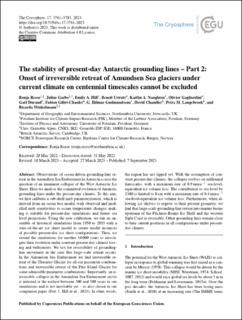| dc.contributor.author | Reese, Ronja | |
| dc.contributor.author | Garbe, Julius | |
| dc.contributor.author | Hill, Emily | |
| dc.contributor.author | Urruty, Benoit | |
| dc.contributor.author | Naughten, Kaitlin | |
| dc.contributor.author | Gagliardini, Olivier | |
| dc.contributor.author | Durand, Gael | |
| dc.contributor.author | Gillet-Chaulet, Fabien | |
| dc.contributor.author | Gudmundsson, G. Hilmar | |
| dc.contributor.author | Chandler, David Matthew | |
| dc.contributor.author | Langebroek, Petra | |
| dc.contributor.author | Winkelmann, Ricarda | |
| dc.date.accessioned | 2023-11-28T14:46:44Z | |
| dc.date.available | 2023-11-28T14:46:44Z | |
| dc.date.created | 2023-09-21T14:00:28Z | |
| dc.date.issued | 2023 | |
| dc.identifier.citation | The Cryosphere. 2023, 17 (9), 3761-3783. | en_US |
| dc.identifier.issn | 1994-0416 | |
| dc.identifier.uri | https://hdl.handle.net/11250/3105073 | |
| dc.description.abstract | Observations of ocean-driven grounding-line retreat in the Amundsen Sea Embayment in Antarctica raise the question of an imminent collapse of the West Antarctic Ice Sheet. Here we analyse the committed evolution of Antarctic grounding lines under the present-day climate. To this aim, we first calibrate a sub-shelf melt parameterization, which is derived from an ocean box model, with observed and modelled melt sensitivities to ocean temperature changes, making it suitable for present-day simulations and future sea level projections. Using the new calibration, we run an ensemble of historical simulations from 1850 to 2015 with a state-of-the-art ice sheet model to create model instances of possible present-day ice sheet configurations. Then, we extend the simulations for another 10 000 years to investigate their evolution under constant present-day climate forcing and bathymetry. We test for reversibility of grounding-line movement in the case that large-scale retreat occurs. In the Amundsen Sea Embayment we find irreversible retreat of the Thwaites Glacier for all our parameter combinations and irreversible retreat of the Pine Island Glacier for some admissible parameter combinations. Importantly, an irreversible collapse in the Amundsen Sea Embayment sector is initiated at the earliest between 300 and 500 years in our simulations and is not inevitable yet – as also shown in our companion paper (Part 1, Hill et al., 2023). In other words, the region has not tipped yet. With the assumption of constant present-day climate, the collapse evolves on millennial timescales, with a maximum rate of 0.9 mm a−1 sea-level-equivalent ice volume loss. The contribution to sea level by 2300 is limited to 8 cm with a maximum rate of 0.4 mm a−1 sea-level-equivalent ice volume loss. Furthermore, when allowing ice shelves to regrow to their present geometry, we find that large-scale grounding-line retreat into marine basins upstream of the Filchner–Ronne Ice Shelf and the western Siple Coast is reversible. Other grounding lines remain close to their current positions in all configurations under present-day climate. | en_US |
| dc.language.iso | eng | en_US |
| dc.rights | Navngivelse 4.0 Internasjonal | * |
| dc.rights.uri | http://creativecommons.org/licenses/by/4.0/deed.no | * |
| dc.title | The stability of present-day Antarctic grounding lines - Part 2: Onset of irreversible retreat of Amundsen Sea glaciers under current climate on centennial timescales cannot be excluded | en_US |
| dc.title.alternative | The stability of present-day Antarctic grounding lines - Part 2: Onset of irreversible retreat of Amundsen Sea glaciers under current climate on centennial timescales cannot be excluded | en_US |
| dc.type | Peer reviewed | en_US |
| dc.type | Journal article | en_US |
| dc.rights.holder | © Author(s) 2023 | en_US |
| dc.description.version | publishedVersion | en_US |
| cristin.ispublished | true | |
| cristin.fulltext | original | |
| cristin.qualitycode | 2 | |
| dc.identifier.doi | 10.5194/tc-17-3761-2023 | |
| dc.identifier.cristin | 2177612 | |
| dc.source.journal | The Cryosphere | en_US |
| dc.source.volume | 17 | en_US |
| dc.source.issue | 9 | en_US |
| dc.source.pagenumber | 3761-3783 | en_US |
| dc.relation.project | EC/H2020/820575 | en_US |

